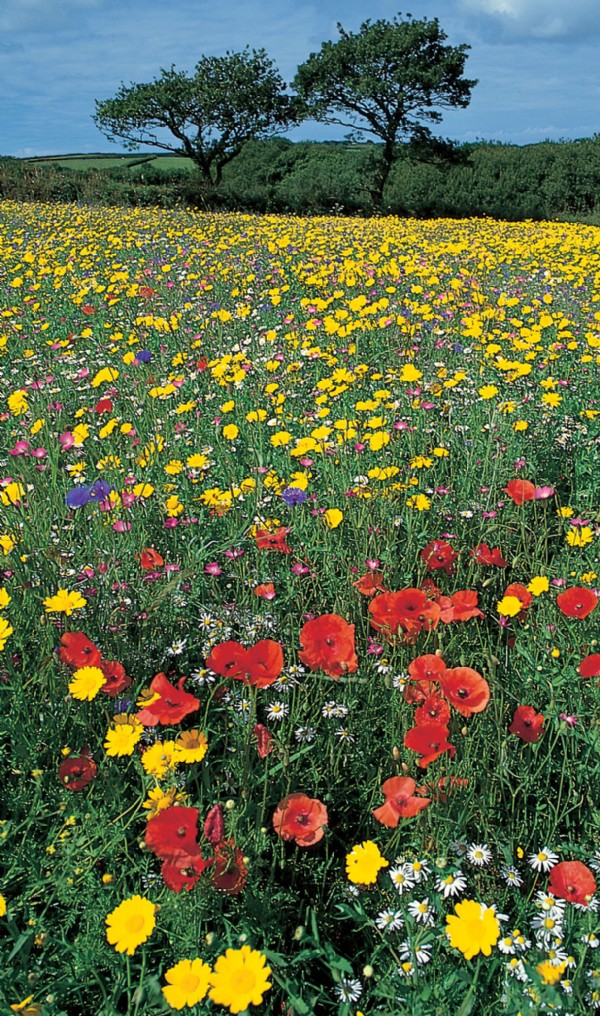

Managing a Meadow
Wild flower meadows take many years to evolve naturally and it is unrealistic to
expect instant results by sowing seeds. Nevertheless, with proper preparationand subsequent management, pleasing results can be observed in a relatively
short time. These days, wild flower meadows are either managed under an
agri-environmental agreement, where a management prescription will be provided by the relevant authority or, as is often the case, for aesthetic purposes, without livestock and not for profit.
An established wild flower meadow requires no fertilisers or chemical inputs, but it still needs managing. If it is treated as a maintenance-free area it quickly reverts to scrub with a dominance of strong-growing species. So, for successful results, some input is needed. The most important requirement is to cut and remove the growth after flowering. (Unless you have very poor growth on thin soil where it may be left in situ.)
It matters not to the plant when the cut takes place and, for most meadows, this is after full flowering in August when the best show is over. It is not unlike a traditional hay cut. The removal of the cuttings may seem laborious, but is extremely effective in lowering the fertility of rich soil allowing delicate wild flowers some ‘elbow’ room.
Herbicides cannot be used with complex seed mixtures as they are not selective enough. Although, in situations where perennial weeds such as docks or thistles need controlling a weedkiller may be spot applied with a knapsack sprayer.
Specialist mixtures for specific soils
The location and physical properties of soil will determine the suitability of a particular grass or wild flower mixture. To obtain the best results it is important to choose a seed mixture that suits the site.
Acidic Soils
These soils are often found on heathland or upland areas and are characteristically of low fertility, with most water-soluble nutrients leached from the topsoil. Although these soils never make the best grade for cropping, they can support a wild flower mixture providing appropriate species are chosen for sowing.
Clay Soils
Usually classified as ‘heavy’, these lie wet in the winter and crack when dry in the summer. There is often difficulty in creating a satisfactory seedbed. It can be beneficial to plough in the autumn, leaving rough over winter and then making final cultivations as conditions allow in the spring before finally sowing as the soil is warming during April or May. It is worth paying special attention to creating the seedbed, especially on clay soils. There is often a very narrow window of opportunity to get the final tilth. Cloddy seedbeds allow slugs to be active and do not allow the seed to get into intimate contact with the soil. Clods bigger than marbles will need to be broken down. Before sowing it is advisable to roll to consolidate the seedbed. This preserves moisture, reduces the nooks and crannies which encourage slugs and stops the seed being sown too deeply.
How to Mow a Meadow
Farmers need not be told how to mow their meadows, but those without proper machinery will need to establish a plan of action. Wild flower meadows become quite tall and bulky when they flower and this presents a problem for those with limited access to agricultural machinery.
However, it is possible to mow with one or two essential bits of equipment. Firstly, a mower will be needed to cut the grass. Most lawnmowers are simply not robust enough to do the job and will get blocked up on the first pass. What is required is an ‘Allen’ sythe. There are other makes available and all do a similar job. These machines have a petrol engine and can be bought or hired. They are easy to use and have a reciprocating knife blade which cuts all vegetation just above ground level. Once cut, the grass should be raked up and taken away. This leaves a stubble which can be mown close/tidied up with a rotary mower.
Please call if you need advice.
Date Posted: 30th March 2017



